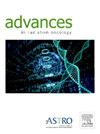精确再照射辅助工具计划(PRISTIN)用于再照射中吸收剂量和分数的处方
IF 2.7
Q3 ONCOLOGY
引用次数: 0
摘要
目的建立一种辅助工具,计算精确再照射的最适宜处方吸收剂量和剂量分数。方法和材料将初始计算机断层扫描的变形图像配准到再照射时的计算机断层扫描后,考虑初始照射恢复的初始生物有效剂量(BED)被逐体素地计算每个危险器官(OAR)的初始生物有效剂量。利用商业放射治疗计划系统,制定临床再照射靶体积(CTV2)。在保持BEDtumor的α/β为CTV2的条件下,通过逐步改变分数的个数来计算临界桨各体素的累积BEDOAR α/β(CBEDOAR α/β)。利用CBEDOAR的α/β-体积直方图确定靶区最合适的处方吸收剂量和再照射的分数。该工具的功能通过2例患者的3种情况进行了计算机验证:1例患者在不同时间的肺周围实质和肺门淋巴区发生肺癌,1例患者在乳腺癌术后放疗后转移性乳腺内淋巴结复发。结果在方案1中,对右肺门CTV2分22段给予57 Gy (57 Gy/22 Fr), CBEDα/β=2最大值为124.078 Gy,不含肿瘤总体积的全肺实质CBEDα/β=2平均值为18.332 Gy。在方案2中,建议对目标的44.152 Gy/7 Fr是最合适的。在方案3中,推荐71.675 Gy/30 Fr质子治疗靶点,复发部位附近主动脉最大cbeda /β=2为145.796 Gy, cbeda /β=2≥100 Gy的体积为0.800 cm3,均在限制范围内。结论该工具可用于确定靶区最合适的处方吸收剂量和精确再照射的分数。本文章由计算机程序翻译,如有差异,请以英文原文为准。
A Precise Reirradiation Supporting Tool Initiative (PRISTIN) for Prescribing Absorbed Dose and Number of Fractions in Reirradiation
Purpose
This study aims to develop a supporting tool to calculate the most appropriate prescribing absorbed dose and number of fractions for precise reirradiation.
Methods and Materials
After deformable image registration of the initial computed tomography to the computed tomography at reirradiation, an initial biological effective dose (BED) taking into account the recovery from the initial irradiation is calculated voxel-by-voxel for each organ at risk (OAR). Using a commercial radiation therapy planning system, the clinical target volume for reirradiation (CTV2) is made. Keeping the BEDtumor’s α/β to CTV2, cumulative BEDOAR’s α/β(CBEDOAR’s α/β) in each voxel of critical OARs is calculated by changing the number of fractions in a stepwise process. The most appropriate prescribing absorbed dose to the target and the number of fractions in reirradiation is determined by using CBEDOAR’s α/β-volume histogram for critical OARs. The function of the tool was validated in silico using 3 scenarios in 2 patients: a patient with a lung cancer at the peripheral lung parenchyma and at the hilar lymphatic region at different times, and in a patient with a metastatic internal mammary lymph node relapsed after postoperative radiation therapy for breast cancer.
Results
In scenario 1, giving 57 Gy in 22 fractions (57 Gy/22 Fr) to the CTV2 at the right hilum, the maximum CBEDα/β=2 was 124.078 Gy, and the mean CBEDα/β=2 of the whole lung parenchyma excluding gross tumor volume was 18.332 Gy. In scenario 2, 44.152 Gy/7 Fr to the target was suggested to be most appropriate. In scenario 3, 71.675 Gy/30 Fr proton therapy to the target was recommended in which the maximum CBEDα/β=2 in the aorta near the recurrence site was 145.796 Gy, and the volume of CBEDα/β=2 ≥ 100 Gy was 0.800 cm3, both are within the constraints.
Conclusions
The tool was suggested to be useful to find the most appropriate prescribing absorbed dose to the target as well as the number of fractions for precise reirradiation.
求助全文
通过发布文献求助,成功后即可免费获取论文全文。
去求助
来源期刊

Advances in Radiation Oncology
Medicine-Radiology, Nuclear Medicine and Imaging
CiteScore
4.60
自引率
4.30%
发文量
208
审稿时长
98 days
期刊介绍:
The purpose of Advances is to provide information for clinicians who use radiation therapy by publishing: Clinical trial reports and reanalyses. Basic science original reports. Manuscripts examining health services research, comparative and cost effectiveness research, and systematic reviews. Case reports documenting unusual problems and solutions. High quality multi and single institutional series, as well as other novel retrospective hypothesis generating series. Timely critical reviews on important topics in radiation oncology, such as side effects. Articles reporting the natural history of disease and patterns of failure, particularly as they relate to treatment volume delineation. Articles on safety and quality in radiation therapy. Essays on clinical experience. Articles on practice transformation in radiation oncology, in particular: Aspects of health policy that may impact the future practice of radiation oncology. How information technology, such as data analytics and systems innovations, will change radiation oncology practice. Articles on imaging as they relate to radiation therapy treatment.
 求助内容:
求助内容: 应助结果提醒方式:
应助结果提醒方式:


